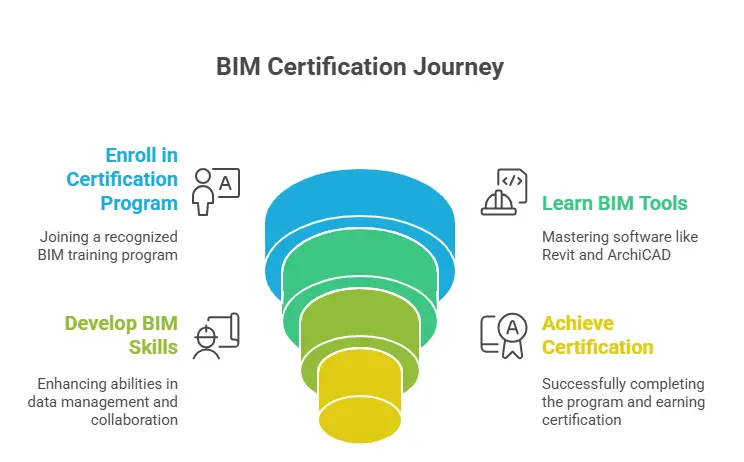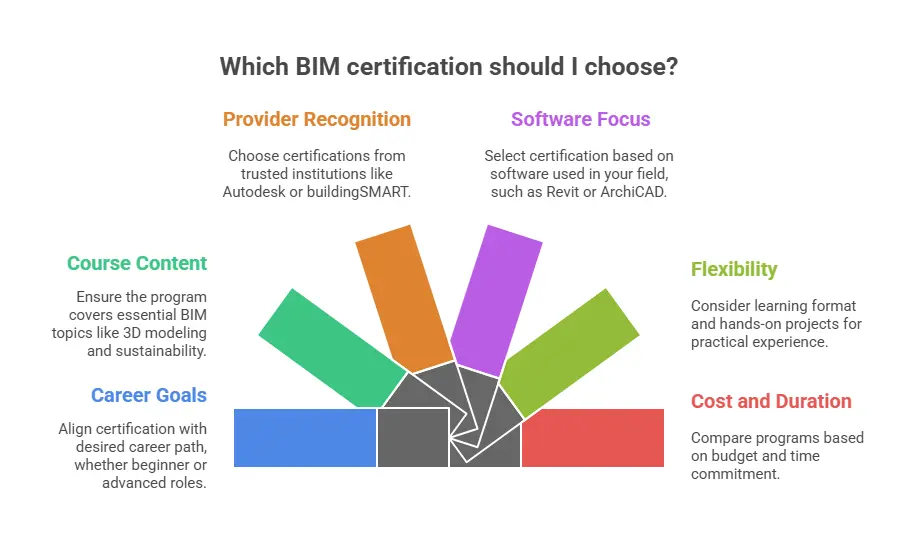Table of Contents
The world of architecture, engineering and construction (AEC) is rapidly changing, and Building Information Modeling (BIM) is at the center of this transformation. As the technology continues to reshape the way buildings are designed and managed, professionals with BIM skills are more valuable than ever. Earning a BIM certification in 2026 can give you a strong advantage and help you stand out in the competitive job market. This not only proves your technical expertise, but additionally shows which you are prepared to work with the today’s digital tools that make the future of the construction and design. Whether you are an architect, engineer or interior designer, BIM certification can open doors to better career opportunities, higher salaries and global recognition.
Get Career-Oriented BIM Certification Course with Expert Mentors! Get a free demo here!
Introduction
By 2026, the AEC (architecture, engineering and construction) industry will continue to evolve with the rise of digital technologies and sustainable practices. The professionals in this field will depend more on tools like Building Information Modeling (BIM), Artificial Intelligence (AI) and automation to manage complex projects effectively.
The demand for skilled professionals who integrate design, generation and sustainability will develop rapidly. AEC careers will no longer simplest recognition on building structures, however additionally on creating smarter, greener and more energy efficient environments. With the right capabilities and certifications, professionals can look forward to diverse profession paths, worldwide possibilities and lengthy-term stability in a area that keeps to shape the sector round us.
What is BIM Certification?
Building Information Modeling (BIM) certification is a expert qualification that proves your expertise and capabilities in using BIM tools and procedures. It suggests which you recognize the way to create, manipulate, and share virtual building fashions successfully. In easy phrases, a BIM certification enables you come to be an expert in cutting-edge design and construction generation — a need to-have talent for professionals in structure, engineering, and construction (AEC).
BIM is greater than simply 3D modeling; it’s a smart procedure that connects layout, records, and collaboration. A licensed expert can deal with every level of a assignment digitally — from making plans and design to production and upkeep. Let’s discover this in detail.
Understanding BIM Certification
A BIM certification application trains professionals to use BIM software program including Autodesk Revit, ArchiCAD, or Navisworks. It teaches now not just a way to create 3D models however additionally a way to control challenge records, coordinate with groups, and ensure accuracy all through a project’s lifecycle.
These programs are usually presented by means of recognized institutions, universities, or software groups. They might also consist of specific stages — novice, intermediate, and superior — relying depending on your experience.
Why BIM Certification is Important
In today’s digital creation global, groups need experts who can work successfully the usage of BIM tools. Getting certified gives you a clean advantage over others because it proves you’ve got each technical and realistic BIM information.
BIM-licensed professionals are regularly trusted with key roles like BIM Coordinator, BIM Modeler, or BIM Manager, in which they manipulate virtual workflows and make sure smooth collaboration among architects, engineers, and contractors.
Benefits of Getting Certified
- Career Growth: BIM certification makes you extra employable and opens doorways to higher-paying jobs within the AEC industry.
- Global Recognition: Many global projects now require BIM-certified experts, providing you with get admission to to worldwide career possibilities.
- Improved Skills: You’ll learn how to use advanced BIM tools, enhance layout accuracy, and manipulate records successfully.
- Future Readiness: As the industry turns into more digital, BIM competencies will be critical for staying relevant for your profession.
The Growing Importance of BIM in AEC
Building Information Modeling (BIM) is rapidly transforming the Architecture, Engineering, and Construction (AEC) enterprise. It has end up one of the maximum important tools for specialists who need to design smarter, construct quicker, and manage initiatives extra efficiently. BIM isn’t pretty much developing 3D models—it’s about connecting layout, statistics, and collaboration all through the complete building process.
Smarter Design and Visualization
BIM lets in architects and engineers to create practical 3D models that show every part of a building, from shape to interiors. These fashions help teams visualize how a task will look and function earlier than production even begins. With this readability, designers could make higher choices early on, decreasing errors and saving time. For clients, BIM offers a clean picture of the very last final results, supporting them recognize the layout extra without problems.
Better Collaboration and Communication
One of BIM’s biggest advantages is the way it improves teamwork. Instead of working one after the other, architects, engineers, and contractors can all collaborate on a unmarried virtual model. This manner absolutely everyone has get admission to to the same updated facts, making communique smoother and lowering misunderstandings. When one character makes a trade, it automatically updates throughout the whole model, retaining the entire team aligned.
Cost and Time Efficiency
BIM allows to reduce project cost with the aid of identifying potential troubles earlier than creation starts. It can locate design clashes—like pipes walking through walls—early in the manner, preventing costly on-web site fixes. It additionally enables in planning substances and scheduling duties more correctly, which results in quicker task crowning glory and much less waste.
Supporting Sustainability
In today’s world, sustainability is a pinnacle precedence, and BIM performs a large role in reaching it. Designers can use BIM to research energy performance, lights, and materials to make buildings extra eco-friendly. This enables create designs that shop power and decrease environmental effect.
A Future-Ready Technology
As the AEC industry movements closer to digital transformation, BIM is becoming a widespread requirement for maximum important projects round the sector. Governments and large groups are now making BIM obligatory for public infrastructure and creation projects. This shift means specialists who understand BIM can have greater career possibilities and lengthy-term process protection.
BIM is not simply an non-obligatory device—it’s the future of the AEC enterprise. It brings together design, information, and teamwork to create better, more green, and sustainable buildings. As technology continues to grow, mastering BIM can be vital for each person who desires to live ahead in the world of architecture, engineering, and construction.
Key Career Advantages of BIM Certification
Building Information Modeling (BIM) certification has become one of the most treasured qualifications for professionals within the Architecture, Engineering, and Construction (AEC) enterprise. It now not handiest improves your technical capabilities however also boosts your profession growth and global possibilities. Let’s explore the principle career advantages of incomes a BIM certification in easy and easy-to-recognize phrases.
🔶Better Job Opportunities
With the developing use of BIM in the AEC industry, corporations are actively seeking out specialists who can paintings with BIM software program and procedures. A BIM certification makes your resume stand out and will increase your chances of getting employed with the aid of pinnacle design and construction companies. Whether you’re an architect, engineer, or dressmaker, BIM expertise opens doors to many thrilling roles which include BIM Modeler, BIM Coordinator, or BIM Manager.
🔶Higher Earning Potential
Professionals with BIM certification regularly earn higher salaries compared to the ones without it. Employers are willing to pay extra for professional professionals who can manipulate virtual fashions, coordinate complicated initiatives, and enhance team efficiency. By proving your knowledge thru certification, you display which you convey greater price to a organisation, that could result in higher pay and quicker promotions.
🔶Global Recognition and Opportunities
BIM is used worldwide, and many international projects now require certified professionals. This means a BIM certification can help you find opportunities not just locally, but globally. Whether you want to work in architecture, construction management, or engineering, your certification is recognized across countries, giving you more flexibility in your career path.
🔶Improved Collaboration and Leadership Skills
Earning a BIM certification facilitates you recognize a way to manage and coordinate digital projects successfully. You learn to paintings with architects, engineers, and contractors the use of the same 3-D model, improving teamwork and lowering mistakes. This enjoy prepares you for management roles, wherein you may oversee task coordination and manual teams toward successful outcomes.
🔶Future-Proof Career
The AEC industry is hastily adopting virtual equipment and sustainable layout strategies. BIM is now a popular requirement for most large tasks. Getting certified ensures you stay applicable and adaptable on this converting surroundings. It facilitates you future-proof your profession via preserving you in advance of industry trends and technologies.
Roles in AEC that Benefit from BIM Certification
Building Information Modeling (BIM) is reshaping how specialists within the Architecture, Engineering, and Construction (AEC) enterprise plan, design, and control initiatives. As BIM becomes the standard for modern-day creation, many jobs inside the AEC discipline are locating new advantages from incomes a BIM certification. It now not best strengthens technical know-how however additionally enables experts paintings extra successfully and collaboratively. Let’s look at a number of the important thing roles that benefit maximum from BIM certification.
🔷Architects
For architects, BIM is a powerful device that helps flip creative ideas into particular digital fashions. A BIM certification lets in architects to layout smarter by way of visualizing each detail — from shape and lighting fixtures to materials and interiors. It also facilitates them locate layout problems early and collaborate without problems with engineers and contractors. Certified architects can lead complicated tasks more expectantly and produce sustainable, records-driven designs that meet cutting-edge building requirements
🔷Civil and Structural Engineers
Engineers benefit substantially from BIM because it improves accuracy and coordination in layout and construction. With BIM certification, civil and structural engineers can examine constructing overall performance, hit upon clashes, and make certain that the design is secure and efficient. BIM additionally enables them talk higher with architects and contractors through shared fashions. This reduces remodel and ensures that initiatives stay on schedule and within budget.
🔷Interior Designers
Interior designers use BIM to devise layouts, materials, lighting, and furnishings with precision. A BIM certification allows them to create practical 3-D visualizations that help clients see how areas will appearance before construction. It additionally lets in designers to coordinate seamlessly with architects and builders, ensuring each layout element suits perfectly. With BIM, interior designers can carry creativity and practicality collectively.
🔷MEP (Mechanical, Electrical, and Plumbing) Engineers
MEP engineers use BIM to create correct systems that combine easily with architectural and structural designs. Certification in BIM helps them version complicated mechanical, electrical, and plumbing structures even as heading off design conflicts. It also improves project planning, set up, and renovation performance.
🔷Project Managers and Construction Professionals
Project managers and construction coordinators benefit from BIM with the aid of the use of it for scheduling, price estimation, and progress tracking. A BIM certification helps them apprehend how to control facts and workflows efficiently. It also permits them to make quicker choices and make certain higher conversation across all challenge levels.
Skills Gained Through BIM Certification
Earning a Building Information Modeling (BIM) certification offers professionals in the Architecture, Engineering, and Construction (AEC) industry a sturdy set of technical and realistic abilities. These abilties help them layout, manage, and execute initiatives greater correctly the use of current virtual equipment. Here are a number of the important thing skills you could gain thru BIM certification, defined in easy and clean-to-recognize terms.
🟠3D Modeling and Visualization Skills
One of the maximum crucial abilties you’ll expand through BIM certification is the potential to create accurate 3D virtual fashions. You’ll discover ways to use popular software program like Autodesk Revit, ArchiCAD, or Navisworks to design homes in detail. These 3D models assist visualize areas actually, identify layout issues early, and present thoughts correctly to customers and challenge groups.
🟠Collaboration and Coordination
BIM teaches specialists how to work together more efficiently. You’ll discover ways to proportion and coordinate models with architects, engineers, and contractors in a single virtual environment. This skill reduces misunderstandings, guarantees all groups live up to date, and allows keep away from costly layout clashes in the course of creation.
🟠Data Management and Analysis
Beyond design, BIM includes managing massive amounts of statistics — which includes materials, charges, and timelines. Certification allows you recognize how to save, organize, and use this information efficiently. You’ll be capable of make knowledgeable choices the usage of real-time project records, enhancing accuracy and productivity.
🟠Project Planning and Scheduling
BIM integrates layout with creation making plans. During certification, you’ll discover ways to link 3D models to time schedules (called 4D BIM) and cost estimates (5D BIM). This lets in you to plot initiatives greater successfully, expect delays, and optimize aid use.
🟠Problem-Solving and Critical Thinking
BIM encourages you to think analytically and clear up design or coordination issues earlier than they emerge as highly-priced on-website online issues. You’ll advantage the capability to locate mistakes early, evaluate options, and make better decisions for the duration of the project lifecycle.
🟠Sustainability and Energy Analysis
Many BIM tools now include features for reading a constructing’s environmental performance. Through certification, you’ll learn how to design strength-green homes by comparing substances, lights, and strength use — an crucial talent for developing sustainable designs.
How to Choose the Right BIM Certification
Choosing the right Building Information Modeling (BIM) certification is an vital step in case you need to grow your profession inside the Architecture, Engineering, and Construction (AEC) industry. With so many packages available, it’s crucial to discover one which suits your skills, desires, and career route. Here’s a easy manual to help you pick the nice BIM certification in your needs.
1️⃣Understand Your Career Goals
- Before deciding on a BIM certification, think about what you want to reap.
- If you’re new to BIM, begin with a newbie-stage certification that covers primary modeling and software program abilties.
- If you have already got enjoy, look for advanced or specialised certifications that target assignment coordination, control, or sustainability.
Your goals—whether you want to be a fashion designer, supervisor, or representative—have to guide your preference.
2️⃣Check the Course Content
Every BIM certification program has a slightly one of a kind attention. Review the syllabus carefully to see what topics are included. A suitable program must include:
- 3-D modeling and visualization
- Collaboration and coordination workflows
- Project records control
- Cost estimation and scheduling (4D and 5D BIM)
- Sustainability and power modeling
Choose a application that balances both technical and realistic capabilities so you can observe them in real-international projects.
3️⃣Look for Recognized Institutions or Providers
Make positive the certification you pick out is obtainable by way of a relied on organisation, university, or software employer. Certifications from well-known businesses like Autodesk, Graphisoft, Bentley Systems, or buildingSMART International are highly respected and drastically acquainted in the enterprise. A recognized certification adds greater value on your resume and will increase your task possibilities international.
4️⃣Consider the Software Focus
Different BIM certifications attention on extraordinary software tools. For instance:
- Autodesk Revit certifications are high-quality for architects and engineers.
- ArchiCAD certifications fit designers who choose intuitive modeling workflows.
- Navisworks or Synchro certifications are best for challenge managers.
Pick the only that aligns with the software program maximum commonly used to your subject or enterprise.
5️⃣Evaluate Flexibility and Learning Format
Check whether the course is available online, offline, or in a hybrid format. If you’re going for walks complete-time, an online or self-paced software might be the notable desire.
. Also, search for applications that offer fingers-on projects, as they assist you gain realistic enjoy.
6️⃣Compare Cost and Duration
BIM certification programs can vary in cost and time commitment. Compare extraordinary alternatives primarily based in your budget and agenda. Sometimes, making an investment in a higher-quality course can pay off in the long run via better career growth.
Key Takeaways
- BIM Skills Are in High Demand: By 2026, most architecture, engineering, and creation companies will require specialists who can use BIM equipment to control digital tasks effectively.
- Boosts Career Growth: A BIM certification makes you greater employable and allows you qualify for advanced roles along with BIM Coordinator, BIM Manager, or Project Lead.
- Higher Salary Potential: Certified BIM professionals regularly earn better salaries due to the fact they bring valuable digital and information management talents to initiatives.
- Global Career Opportunities: BIM is now used international, and authorized professionals are identified throughout nations, allowing for worldwide job possibilities.
- Enhances Collaboration: BIM-certified experts can paintings higher with architects, engineers, and contractors the usage of shared digital models, reducing mistakes and improving assignment results.
- Supports Sustainable Design: BIM helps in growing green and energy-green designs with the aid of studying materials, lights, and building performance.
- Keeps You Future-Ready: As the AEC industry turns into greater digital and records-pushed, BIM certification guarantees you stay up to date with the ultra-cutting-edge technology and company requirements.
- Increases Efficiency and Accuracy: Certified professionals can manipulate facts, discover format clashes early, and complete projects quicker with fewer errors.
- Builds Leadership and Management Skills: BIM schooling facilitates professionals lead digital initiatives, coordinate groups, and make smarter, facts-primarily based decisions.
- Essential for Long-Term Career Success: In 2026 and past, BIM certification gained’t simply be an introduced talent—it will be a necessity for each person aiming to build a successful, future-proof AEC career.
Get Career-Oriented BIM Certification Course with Expert Mentors! Get a free demo here!
Conclusion
BIM certification is turning into a need to for everyone searching for growth inside the architecture, engineering and construction (AEC) industry. As tasks turn out to be more digital, collaborative and data-pushed, BIM abilties help professionals stay in advance of the curve. A certification not only improves your technical expertise, but also opens doors to higher job opportunities, higher salaries and worldwide recognition. By 2026, having a BIM certification will not most effective benefit you – it will likely be vital to constructing a successful and future-ready AEC career.
| Related Links | |
| BIM in Interior Design: Benefits and Career Opportunities | How to become a BIM Specialist in 2025? |
Master BIM and Elevate Your Career – Enroll Today!
Stay ahead in the construction and design industry with our comprehensive BIM Course! Learn Building Information Modeling (BIM) from experts, gain hands-on experience with top software, and boost your career prospects. Join now and become a certified BIM professional!
Know MoreFrequently Asked Questions
What is BIM certification?
A BIM certification is a professional qualification that proves your knowledge and skills in Building Information Modeling (BIM) tools and workflows. It shows that you can design, manage, and coordinate construction projects digitally and efficiently.
Why is BIM certification important for AEC professionals in 2026?
By 2026, the AEC industry will rely heavily on digital design and collaboration. A BIM certification helps professionals stay relevant, improve efficiency, and qualify for roles that require advanced technical skills in digital project management.
Who should consider getting a BIM certification?
BIM certification is ideal for architects, civil engineers, structural engineers, interior designers, MEP professionals, and project managers who want to grow their careers and stay competitive in the digital construction era.
How does BIM certification improve career opportunities?
Certified professionals have better job prospects because companies prefer candidates who can manage BIM workflows. It can lead to roles such as BIM Modeler, BIM Coordinator, BIM Manager, or Digital Project Lead — with higher salaries and leadership opportunities.
Is BIM certification recognized internationally?
Yes. BIM certification from recognized providers like Autodesk, Graphisoft, or buildingSMART is accepted globally. It helps professionals find job opportunities across different countries and international projects.
What skills will I learn through BIM certification?
You’ll learn 3D modeling, project coordination, data management, cost estimation, and sustainable design analysis. It also helps you develop teamwork, problem-solving, and leadership skills.
How long does it take to complete a BIM certification?
The duration depends on the course level and provider. Most BIM certification programs take between a few weeks to a few months to complete, depending on whether they are beginner, intermediate, or advanced level.
Does BIM certification increase salary potential?
Yes. Professionals with BIM certification often earn higher salaries because they bring valuable digital and data management skills that improve project accuracy, collaboration, and cost efficiency.














